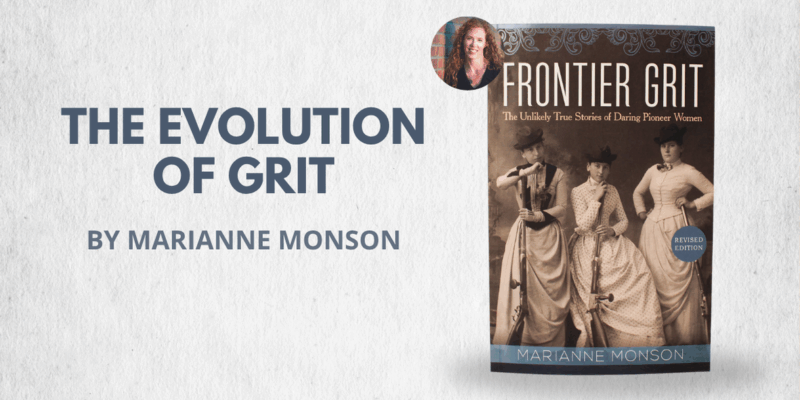
By Marianne Monson, Author of Frontier Grit
In 2015, I was in the thick of researching and writing the first edition of Frontier Grit. At the time, Hilary Clinton was the first female candidate to represent a major U.S. political party. Bree Newsome had been arrested for climbing the flagpole of the South Carolina State House to remove its Confederate flag. The U.S. military had recently opened all combat roles to women.
Though the field of women’s history—the study of history through the lens of gender—began in the 1970s and had a flourishing in the 90s, the past ten years have seen a veritable explosion in this area, for both the academic and popular spheres. At last, we have begun to remedy the fact that the traditional study of history ignored and neglected the experience of half the world’s population.
Early efforts in the area attempted to rescue the stories of women who excelled by traditionally male measurements—that is women who managed to attain political, economic, or artistic power and excellence. As the field evolved, we began to recognize that beyond achieving in traditionally male spheres, women have always been creating history by contributing in a myriad of ways to the social fabric of humanity.
Frontier Grit was a labor of love motivated by the belief that women’s stories matter. I was lucky to have been raised on such stories by my maternal grandmother, Alice Evans Allred, who was a remarkable storyteller. In her eighties, she learned how to use email so she could send out a weekly report, turning day to day happenings into pithy narratives I still like to reread. In her youth, she wanted to be a journalist and was accepted at an out of state program, but her father refused to let her go and required her to become a kindergarten teacher instead. Though she outwardly complied, she found many other ways to become a writer. Contrasting my grandmother’s story with thousands of options available to my own daughter today reminds me of how far we have come over the past few generations. As I sent the second edition of the book to print in the final days of 2024, I couldn’t help but think that we still have quite a long way to go.
Frontier Grit was my first non-fiction book, and I learned a great deal through the writing of it. Intuitively I knew I wanted to include women few readers had heard of, who had accomplished remarkable things. But I also wanted to include women who would typically never be included in such a book, motivated by the twin beliefs that women have always been contributing in remarkable ways and that the value added to the fabric of the everyday also adds to the fabric of our nation.
With the help of readers, librarians, teachers, and an award nomination by the American Library Association, this book succeeded far beyond my hopes for it. Most meaningful to me were the letters I received from readers saying how much they connected with these women and drew strength from their stories. As I started speaking publicly about the book, my own career trajectory took a sharp turn and I realized this was an area I wanted to write about for many years to come. In many ways, Frontier Grit brought my subsequent books Women of the Blue and Gray and The Opera Sisters into being.
Over the past nine years, the lives of U.S. women have advanced in many ways. Pay gaps have narrowed; sexual harassment has decreased; music and films created by and for women have been incredibly successful. More women of color are represented in positions of power than ever before. The old narratives about the formation of this country are being questioned and revisited, reworked and retold.
But women still earn 78 cents on the dollar compared to men. Women still carry the large percentage of the burdens of childcare and housework, even if they’re employed. Women hold less than 25% of political offices in the U.S and 81% of U.S. women have experienced sexual harassment or assault. The office of female U.S. president continues to elude us. There is still much left to be done and the telling of stories from the past are an essential part of reshaping the world in greater equity.
The cycles of history spin on in eddies and echoes. Uruguayan writer Eduardo Galeano famously said, “History never really says goodbye, history says ‘see you later.’” The challenges these women faced are familiar to us, for they are twisting threads we continue to grapple with today.
Nine years later, the twelve women in this book still inspire me. Many times in the past decade, when faced with moments of challenge that threatened to send me into despair, I’ve turned to Clara Brown, Zitkala-Sa and Abigail Scott Duniway. I’ve remembered the harrowing odds aligned against them and their unrelenting strength in the face of those odds. I’ve continued onward, inspired and emboldened by their stories.

NEW! Frontier Grit: The Unlikely True Stories of Daring Pioneer Women: Discover the stories of twelve women who “heard the call” to settle the west and who came from all points of the globe to begin their journey.

MARIANNE MONSON received her MFA in Creative Writing from Vermont College of Fine Arts and primarily writes on topics related to women’s history. She has taught English and Creative Writing at the community college and university levels and is the author of twelve books for children and adults, including the novel Her Quiet Revolution and her nonfiction works Frontier Grit and Women of the Blue and Gray.
She is the founder of The Writer’s Guild, a literary nonprofit, and writes from a 100-year-old house in Astoria, Oregon.
Visit her at mariannemonson.com